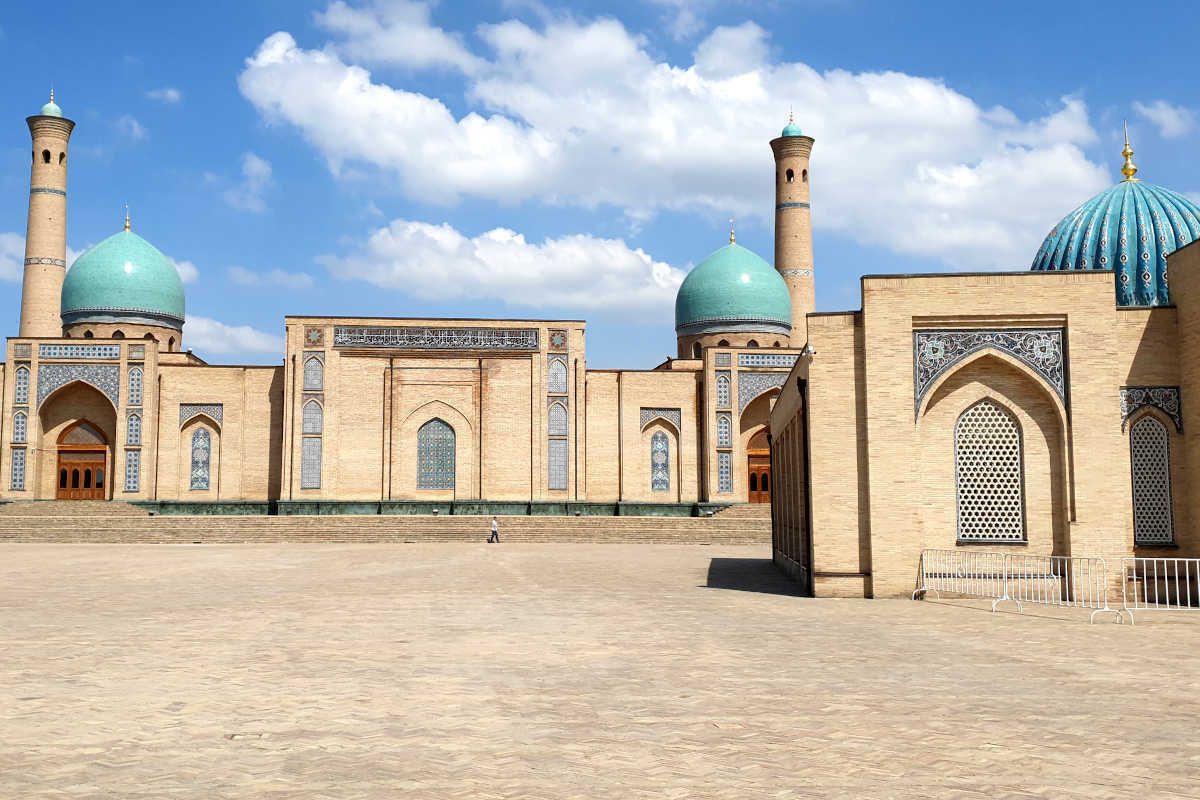Tashkent - Complex Khast Imam
The complex was built on the tomb of one of the first Imams of Tashkent, the famous scholar, expert of the Koran and Hadith, poet, craftsman Abubakr Muhammad Kaffali Shashi (d. in the Xth century) or Hazrati Imam (Khast Imam for short). According to legend, he was nicknamed “Kaffal” (“the master key maker”) for making an amazing lock whose key weighed one and a half kilograms. His tomb was highly revered. The entire area in this part of the old city was named Imam after Sheikh Hazrati. In the XVI century, a mausoleum was built over the Sheikh’s tomb. Despite the fact that the building of the mausoleum was repeatedly repaired, the walls of the old part of the mausoleum remained fired bricks and a unique decoration for Tashkent – majolica of the XVI century with a historical inscription with the names of the architect and calligrapher, as well as the date of construction – 1541-1542. This monument is of great historical and artistic value.

In the sixteenth century, the base of the ensemble was the Barak-khan madrasah. There is a rich library of oriental manuscripts. Opposite the Barak-khan Madrasah is the Tilla Sheikh Mosque (19th century).
The Khast Imam complex also includes the Muyi Muborak Madrasah of Tashkent, which means “blessed hair”. According to legend, a hair of the Prophet Muhammad (s.a.w.) – a holy relic of Muslims – is kept in the madrasa. The building dates back to the 16th century and has been restored several times. The Muyi-Mubarak Madrasah houses the world-famous Qur’an of Caliph Osman, the oldest in the world. This Koran is the first source of the holy book, written on the skin of a deer in the middle of the VII century. Only 6 such Korans were written. There are only 4 copies left in the world and the best preserved is in Uzbekistan. There are scattered pages of the remaining 4 Qurans in England, Turkey and Egypt. The officially accepted version of how the Quran came to Uzbekistan from Osman is as follows: When Amir Temur defeated the Turkish ruler Bayazid in 1402, the great general passed through the Iraqi city of Basra, from where he took the Quran and brought it to Samarkand, where it was kept in a madrasa. In 1869, the Russian general von Kaufman conquered the city of Samarkand and brought the Koran of Osman to the imperial library in St. Petersburg. In 1917, a letter is written to the government in Uzbekistan requesting that the Koran of Osman be returned to its true owner. In 1924, the Koran of Osman was brought to Tashkent in a special carriage, where it is kept in the Museum of the History of the Peoples of Uzbekistan. In 1989, the Koran was handed over to the Spiritual Administration of Muslims of the Republic of Uzbekistan for permanent safekeeping. Now it is kept in a sarcophagus from Germany, which automatically maintains the optimal humidity and temperature.
The building of the Spiritual Administration of Muslims of Uzbekistan, which houses more than 22 thousand religious books, was built in 2007 next to the Muyi Muborak Madrasah.
In the same year 2007, a new building of the mosque “Hazrati Imam” was built according to the rules of XVI century architecture with two minarets, whose gallery “Aiwan” represents the fine work of woodcarvers of different schools (from Kokand, Samarkand and Bukhara). Exotic trees, shrubs and flowers from different countries were brought for this complex. Thanks to the successful lighting, the architectural complex is reminiscent of a picture from “1000 and one nights”.
